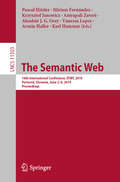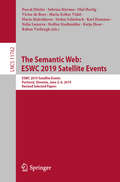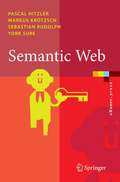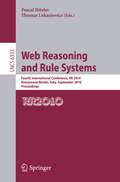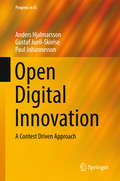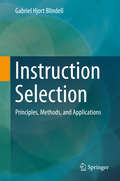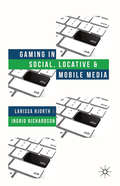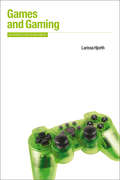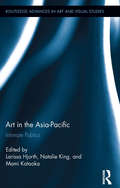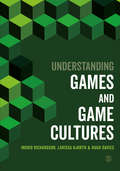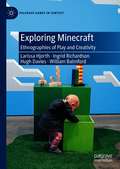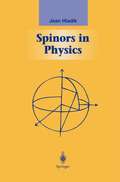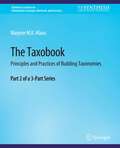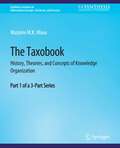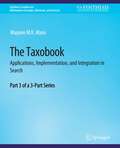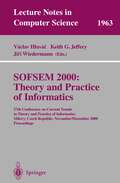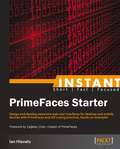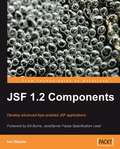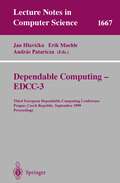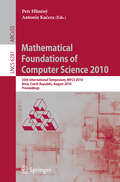- Table View
- List View
The Semantic Web: 16th International Conference, ESWC 2019, Portorož, Slovenia, June 2–6, 2019, Proceedings (Lecture Notes in Computer Science #11503)
by Pascal Hitzler Miriam Fernández Krzysztof Janowicz Amrapali Zaveri Alasdair J. G. Gray Vanessa Lopez Armin Haller Karl HammarThis book constitutes the refereed proceedings of the 16th International Semantic Web Conference, ESWC 2019, held in Portorož, Slovenia. The 39 revised full papers presented were carefully reviewed and selected from 134 submissions. The papers are organized in three tracks: research track, resources track, and in-use track and deal with the following topical areas: distribution and decentralisation, velocity on the Web, research of research, ontologies and reasoning, linked data, natural language processing and information retrieval, semantic data management and data infrastructures, social and human aspects of the Semantic Web, and, machine learning.
The Semantic Web: ESWC 2019 Satellite Events, Portorož, Slovenia, June 2–6, 2019, Revised Selected Papers (Lecture Notes in Computer Science #11762)
by Pascal Hitzler Sabrina Kirrane Olaf Hartig Victor De Boer Maria-Esther Vidal Maria Maleshkova Stefan Schlobach Karl Hammar Nelia Lasierra Steffen Stadtmüller Katja Hose Ruben VerborghThis book constitutes the thoroughly refereed post-conference proceedings of the Satellite Events of the 16th Extended Semantic Web Conference, ESWC 2019, held in Portorož, Slovenia, in June 2019.The volume contains 38 poster and demonstration papers, 2 workshop papers,5 PhD symposium papers, and 3 industry track papers, selected out of a total of 68 submissions. They deal with all areas of semantic web research, semantic technologies on the Web and Linked Data.
Semantic Web: Grundlagen (eXamen.press)
by Pascal Hitzler Markus Krötzsch Sebastian Rudolph York SureDas Buch Semantic Web – Grundlagen vermittelt als erstes deutschsprachiges Lehrbuch die Grundlagen des Semantic Web in verständlicher Weise. Es ermöglicht einen einfachen und zügigen Einstieg in Methoden und Technologien des Semantic Web und kann z.B. als solide Grundlage für die Vorbereitung und Durchführung von Vorlesungen genutzt werden. Die Autoren trennen dabei sauber zwischen einer intuitiven Hinführung zur Verwendung semantischer Technologien in der Praxis einerseits, und der Erklärung formaler und theoretischer Hintergründe andererseits. Nur für letzteres werden Grundkenntnisse in Logik vorausgesetzt, die sich bei Bedarf jedoch durch zusätzliche Lektüre und mit Hilfe eines entsprechenden Kapitels im Anhang aneignen lassen. Das Lehrbuch richtet sich primär an Studenten mit Grundkenntnissen in Informatik sowie an interessierte Praktiker welche sich im Bereich Semantic Web fortbilden möchten. Aus den Rezensionen: "… RDF, RDF-S und OWL. Diese Sprachen … werden von den Autoren dargestellt. Bei der Darstellung … fallen sie selten zu schwierigen Fachslang, sondern liefern eine gut nachvollziehbare Schilderung mit einfachen Beispielen, auch Übungsaufgaben runden die Kapitel ab. … Semantic Web ist ein einfach geschriebenes und anschauliches Buch, das In die Grundkonzepte der Semantic-Web-Techniken einführt. Wer sich schnell in RDF, RDF-S und Co. einarbeiten muss und etwas Vorbildung in Logik und Algebra mitbringt, der trifft mit diesem Lehrbuch sicherlich eine gute Wahl …" (http://www.literaturnetz.com/content/view/8742/44/)
Web Reasoning and Rule Systems: Fourth International Conference, RR 2010, Bressanone/Brixen, Italy, September 22-24, 2010. Proceedings (Lecture Notes in Computer Science #6333)
by Pascal Hitzler Thomas LukasiewiczOpen Digital Innovation: A Contest Driven Approach (Progress in IS)
by Anders Hjalmarsson Gustaf Juell-Skielse Paul JohannessonThis book explores how novel digital services, including e-services, digital platforms and mobile apps, are increasingly being innovated through open processes. It investigates how and why organizations invite external developers to participate in their innovation, often catalyzed by contests and the provision of open data, with the aim of designing digital services that go beyond the capability of the organizations themselves. Taking a contest driven approach to innovation, the book provides an accessible yet comprehensive introduction to the area of open digital innovation. It offers an analysis of key scientific principles underlying open innovation and based on these provides practical tools for improving the digital innovation process. Furthermore, the book introduces instruments for managing innovation contests, in particular for overcoming innovation barriers and for harnessing the power of motivating factors. It serves as a text for graduate and undergraduate courses in digital innovation and entrepreneurship, but is also a valuable resource for managers as well as policy makers in the field of open digital innovation.
Triangulations and Applications (Mathematics and Visualization)
by Øyvind Hjelle Morten DæhlenThis book will serve as a valuable source of information about triangulations for the graduate student and researcher. With emphasis on computational issues, it presents the basic theory necessary to construct and manipulate triangulations. In particular, the book gives a tour through the theory behind the Delaunay triangulation, including algorithms and software issues. It also discusses various data structures used for the representation of triangulations.
Instruction Selection: Principles, Methods, and Applications
by Gabriel Hjort BlindellThis book presents a comprehensive, structured, up-to-date survey on instruction selection. The survey is structured according to two dimensions: approaches to instruction selection from the past 45 years are organized and discussed according to their fundamental principles, and according to the characteristics of the supported machine instructions. The fundamental principles are macro expansion, tree covering, DAG covering, and graph covering. The machine instruction characteristics introduced are single-output, multi-output, disjoint-output, inter-block, and interdependent machine instructions. The survey also examines problems that have yet to be addressed by existing approaches. The book is suitable for advanced undergraduate students in computer science, graduate students, practitioners, and researchers.
Gaming in Social, Locative and Mobile Media
by L. Hjorth I. RichardsonDrawing on case studies across the Asia-Pacific region, Gaming in Social, Locative and Mobile Media explores the 'playful turn' in contemporary everyday life, and the role of mobile devices, games and social media in this transformation.
Games and Gaming: An Introduction to New Media (Berg New Media Series)
by Larissa HjorthThe computer games industry has rapidly matured. Once a preoccupation only of young technophiles, games are now one of the dominant forms of global popular culture. From consoles such as Nintendo Wii and Microsoft Xbox to platforms such as iPhones and online gaming worlds, the realm of games and their scope has become all-pervasive.The study of games is no longer a niche interest but rather an integral part of cultural and media studies. The analysis of games reveals much about contemporary social relations, online communities and media engagement.Presenting a range of approaches and analytical tools through which to explore the role of games in everyday life, and packed with case material, Games and Gaming provides a comprehensive overview of this new media and how it permeates global culture in the twenty-first century.
Art in the Asia-Pacific: Intimate Publics (Routledge Advances in Art and Visual Studies)
by Larissa Hjorth Natalie King Mami KataokaAs social, locative, and mobile media render the intimate public and the public intimate, this volume interrogates how this phenomenon impacts art practice and politics. Contributors bring together the worlds of art and media culture to rethink their intersections in light of participatory social media. By focusing upon the Asia-Pacific region, they seek to examine how regionalism and locality affect global circuits of culture. The book also offers a set of theoretical frameworks and methodological paradigms for thinking about contemporary art practice more generally.
Art in the Asia-Pacific: Intimate Publics (Routledge Advances in Art and Visual Studies)
by Larissa Hjorth Natalie King Mami KataokaAs social, locative, and mobile media render the intimate public and the public intimate, this volume interrogates how this phenomenon impacts art practice and politics. Contributors bring together the worlds of art and media culture to rethink their intersections in light of participatory social media. By focusing upon the Asia-Pacific region, they seek to examine how regionalism and locality affect global circuits of culture. The book also offers a set of theoretical frameworks and methodological paradigms for thinking about contemporary art practice more generally.
Understanding Games and Game Cultures
by Larissa Hjorth Ingrid Richardson Hugh DaviesDigital games are one of the most significant media interfaces of contemporary life. Games today interweave with the social, economic, material, and political complexities of living in a digital age. But who makes games, who plays them, and what, how and where do we play? This book explores the ways in which games and game cultures can be understood. It investigates the sites, genres, platforms, interfaces and contexts for games and gameplay, offering a critical overview of the breadth of contemporary game studies. It is an essential companion for students looking to understand games and games cultures in our increasingly playful and ‘gamified’ digital society.
Understanding Games and Game Cultures
by Larissa Hjorth Ingrid Richardson Hugh DaviesDigital games are one of the most significant media interfaces of contemporary life. Games today interweave with the social, economic, material, and political complexities of living in a digital age. But who makes games, who plays them, and what, how and where do we play? This book explores the ways in which games and game cultures can be understood. It investigates the sites, genres, platforms, interfaces and contexts for games and gameplay, offering a critical overview of the breadth of contemporary game studies. It is an essential companion for students looking to understand games and games cultures in our increasingly playful and ‘gamified’ digital society.
Understanding Games and Game Cultures
by Larissa Hjorth Ingrid Richardson Hugh DaviesDigital games are one of the most significant media interfaces of contemporary life. Games today interweave with the social, economic, material, and political complexities of living in a digital age. But who makes games, who plays them, and what, how and where do we play? This book explores the ways in which games and game cultures can be understood. It investigates the sites, genres, platforms, interfaces and contexts for games and gameplay, offering a critical overview of the breadth of contemporary game studies. It is an essential companion for students looking to understand games and games cultures in our increasingly playful and ‘gamified’ digital society.
Exploring Minecraft: Ethnographies of Play and Creativity (Palgrave Games in Context)
by Larissa Hjorth Ingrid Richardson Hugh Davies William BalmfordThis book directs critical attention to one of the most ubiquitous and yet under-analyzed games, Minecraft. Drawing on three years of ethnographic fieldwork into mobile games in Australian homes, the authors seek to take Minecraft seriously as a cultural practice. The book examines how Minecraft players engage in a form of gameplay that is uniquely intergenerational, creative, and playful, and which moves ambivalently throughout everyday life. At the intersection of digital media, quotidian literacy, and ethnography, the book situates interdisciplinary debates around mundane play through the lens of Minecraft. Ultimately, Exploring Minecraft seeks to coalesce the discussion between formal and informal learning, fostering new forms of digital media creativity and ethnographic innovation around the analysis of games in everyday life.
Spinors in Physics (Graduate Texts in Contemporary Physics)
by Jean HladikInvented by Dirac in creating his relativistic quantum theory of the electron, spinors are important in quantum theory, relativity, nuclear physics, atomic and molecular physics, and condensed matter physics. Essentially, they are the mathematical entities that correspond to electrons in the same way that ordinary wave functions correspond to classical particles. Because of their relations to the rotation group SO(n) and the unitary group SU(n), this discussion will be of interest to applied mathematicians as well as physicists.
The Taxobook: Principles and Practices of Building Taxonomies, Part 2 of a 3-Part Series (Synthesis Lectures on Information Concepts, Retrieval, and Services)
by Marjorie HlavaThis book outlines the basic principles of creation and maintenance of taxonomies and thesauri. It also provides step by step instructions for building a taxonomy or thesaurus and discusses the various ways to get started on a taxonomy construction project. Often, the first step is to get management and budgetary approval, so I start this book with a discussion of reasons to embark on the taxonomy journey. From there I move on to a discussion of metadata and how taxonomies and metadata are related, and then consider how, where, and why taxonomies are used. Information architecture has its cornerstone in taxonomies and metadata. While a good discussion of information architecture is beyond the scope of this work, I do provide a brief discussion of the interrelationships among taxonomies, metadata, and information architecture. Moving on to the central focus of this book, I introduce the basics of taxonomies, including a definition of vocabulary control and why it is so important, how indexing and tagging relate to taxonomies, a few of the types of tagging, and a definition and discussion of post- and pre-coordinate indexing. After that I present the concept of a hierarchical structure for vocabularies and discuss the differences among various kinds of controlled vocabularies, such as taxonomies, thesauri, authority files, and ontologies. Once you have a green light for your project, what is the next step? Here I present a few options for the first phase of taxonomy construction and then a more detailed discussion of metadata and markup languages. I believe that it is important to understand the markup languages (SGML and XML specifically, and HTML to a lesser extent) in relation to information structure, and how taxonomies and metadata feed into that structure. After that, I present the steps required to build a taxonomy, from defining the focus, collecting and organizing terms, analyzing your vocabulary for even coverage over subject areas, filling in gaps, creating relationships between terms, and applying those terms to your content. Here I offer a cautionary note: don’t believe that your taxonomy is “done!” Regular, scheduled maintenance is an important—critical, really—component of taxonomy construction projects. After you’ve worked through the steps in this book, you will be ready to move on to integrating your taxonomy into the workflow of your organization. This is covered in Book 3 of this series. Table of Contents: List of Figures / Preface / Acknowledgments / Building a Case for Building a Taxonomy / Taxonomy Basics / Getting Started / Terms: The Building Blocks of a Taxonomy / Building the Structure of Your Taxonomy / Evaluation and Maintenance / Standards and Taxonomies / Glossary / End Notes / Author Biography
The Taxobook: History, Theories, and Concepts of Knowledge Organization, Part 1 of a 3-Part Series (Synthesis Lectures on Information Concepts, Retrieval, and Services)
by Marjorie HlavaThis is the first volume in a series about creating and maintaining taxonomies and their practical applications, especially in search functions. In Book 1 (The Taxobook: History, Theories, and Concepts of Knowledge Organization), the author introduces the very foundations of classification, starting with the ancient Greek philosophers Plato and Aristotle, as well as Theophrastus and the Roman Pliny the Elder. They were first in a line of distinguished thinkers and philosophers to ponder the organization of the world around them and attempt to apply a structure or framework to that world. The author continues by discussing the works and theories of several other philosophers from Medieval and Renaissance times, including Saints Aquinas and Augustine, William of Occam, Andrea Cesalpino, Carl Linnaeus, and René Descartes. In the 17th, 18th, and 19th centuries, John Locke, Immanuel Kant, James Frederick Ferrier, Charles Ammi Cutter, and Melvil Dewey contributed greatly to the theories of classification systems and knowledge organization. Cutter and Dewey, especially, created systems that are still in use today. Chapter 8 covers the contributions of Shiyali Ramamrita Ranganathan, who is considered by many to be the “father of modern library science.” He created the concept of faceted vocabularies, which are widely used—even if they are not well understood—on many e-commerce websites. Following the discussions and historical review, the author has included a glossary that covers all three books of this series so that it can be referenced as you work your way through the second and third volumes. The author believes that it is important to understand the history of knowledge organization and the differing viewpoints of various philosophers—even if that understanding is only that the differing viewpoints simply exist. Knowing the differing viewpoints will help answer the fundamental questions: Why do we want to build taxonomies? How do we build them to serve multiple points of view? Table of Contents: List of Figures / Preface / Acknowledgments / Origins of Knowledge Organization Theory: Early Philosophy of Knowledge / Saints and Traits: Realism and Nominalism / Arranging the glowers… and the Birds, and the Insects, and Everything Else: Early Naturalists and Taxonomies / The Age of Enlightenment Impacts Knowledge Theory / 18th-Century Developments: Knowledge Theory Coming to the Foreground / High Resolution: Classification Sharpens in the 19th and 20th Centuries / Outlining the World and Its Parts / Facets: An Indian Mathematician and Children’s Toys at Selfridge’s / Points of Knowledge / Glossary / End Notes / Author Biography
The Taxobook: Applications, Implementation, and Integration in Search, Part 3 of a 3-Part Series (Synthesis Lectures on Information Concepts, Retrieval, and Services)
by Marjorie M.K. HlavaThis book is the third of a three-part series on taxonomies, and covers putting your taxonomy into use in as many ways as possible to maximize retrieval for your users. Chapter 1 suggests several items to research and consider before you start your implementation and integration process. It explores the different pieces of software that you will need for your system and what features to look for in each. Chapter 2 launches with a discussion of how taxonomy terms can be used within a workflow, connecting two—or more—taxonomies, and intelligent coordination of platforms and taxonomies. Microsoft SharePoint is a widely used and popular program, and I consider their use of taxonomies in this chapter. Following that is a discussion of taxonomies and semantic integration and then the relationship between indexing and the hierarchy of a taxonomy. Chapter 3 (“How is a Taxonomy Connected to Search?”) provides discussions and examples of putting taxonomies into use in practical applications. It discusses displaying content based on search, how taxonomy is connected to search, using a taxonomy to guide a searcher, tools for search, including search engines, crawlers and spiders, and search software, the parts of a search-capable system, and then how to assemble that search-capable system. This chapter also examines how to measure quality in search, the different kinds of search, and theories on search from several famous theoreticians—two from the 18th and 19th centuries, and two contemporary. Following that is a section on inverted files, parsing, discovery, and clustering. While you probably don’t need a comprehensive understanding of these concepts to build a solid, workable system, enough information is provided for the reader to see how they fit into the overall scheme. This chapter concludes with a look at faceted search and some possibilities for search interfaces. Chapter 4, “Implementing a Taxonomy in a Database or on a Website,” starts where many content systems really should—with the authors, or at least the people who create the content. This chapter discusses matching up various groups of related data to form connections, data visualization and text analytics, and mobile and e-commerce applications for taxonomies. Finally, Chapter 5 presents some educated guesses about the future of knowledge organization. Table of Contents: List of Figures / Preface / Acknowledgments / On Your Mark, Get Ready …. WAIT! Things to Know Before You Start the Implementation Step / Taxonomy and Thesaurus Implementation / How is a Taxonomy Connected to Search? / Implementing a Taxonomy in a Database or on a Website / What Lies Ahead for Knowledge Organization? / Glossary / End Notes / Author Biography
SOFSEM 2000: 27th Conference on Current Trends in Theory and Practice of Informatics Milovy, Czech Republic, November 25 - December 2, 2000 Proceedings (Lecture Notes in Computer Science #1963)
by Vaclav Hlavac Keith G. Jeffery Jirí WiedermannThe international conference on current trends in the theory and practice of informatics SOFSEM 2000 was held 25 November–2 December 2000 in the c- ference facilities of the Dev?et Skal (Nine Rocks) Hotel, Milovy, Czech-Moravian Highlands, the Czech Republic. It was already the 27th annual meeting in the series of SOFSEM conferences organized in either the Czech or the Slovak Rep- lic. Since its establishment in 1974, SOFSEM has gone through a long dev- opment in parallel with the entire ?eld of informatics. Currently SOFSEM is a wide-scope, multidisciplinary conference, with stress on the interplay between the theory and practice of informatics. The SOFSEM scienti?c program consists mainly of invited talks which determine the topics of the conference. Invited talks are complemented by short refereed talks contributed by SOFSEM parti- pants. The topics of invited talks are chosen so as to cover the span from theory to practice and to bring interesting research areas to the attention of conf- ence participants. For the year 2000, the following three streams were chosen for presentation by the SOFSEM Steering Committee: – Trends in Algorithmics – Information Technologies in Practice – Computational Perception The above streams were covered through 16 invited talks given by prominent researchers. There were 18 contributed talks also presented, chosen by the int- national Program Committee from among 36 submitted papers. The program also included a panel on lessons learned from the Y2K problem.
Instant PrimeFaces Starter
by Ian HlavatsGet to grips with a new technology, understand what it is and what it can do for you, and then get to work with the most important features and tasks. Instant Primefaces Starter is a fast-paced, introductory guide designed to give you all the information you need to start using Primfaces, instantly.Instant PrimeFaces Starter is great for developers looking to get started quickly with PrimeFaces. It's assumed that you have some JSF experience already, as well as familiarity with other Java technologies such as CDI and JPA and an understanding of MVC principles, object-relational mapping (ORM), and dependency injection (DI). The sample application included with the book is fully functional and demonstrates how to use these technologies together with PrimeFaces.
JSF 1.2 Components: Develop Advanced Ajax-enabled Jsf Applications
by Ian HlavatsA tutorial in the Beginner's Guide series, offering the reader step-by-step instructions on building and customizing their MOLSB web site from scratch. This book is also packed with tips, tricks, and best practices. Small-business owners who want to build and customize their business web sites on Microsoft's free-to-use platform. No technical knowledge is required.This book is a practical, hands-on guide to learning JavaServer Faces components based on a fictitious computer hardware e-commerce application. It adopts an example-driven approach focused on solving common web application development tasks using a wide range of JSF components from today's most popular JSF component libraries.Each chapter covers a different JSF component library and includes dozens of examples complete with Java source code listings, JSF markup, screenshots, and developer tips. If you are a professional web application developer interested in learning JavaServer Faces having an intermediate to advanced level of Java programming experience and a good understanding of HTML, CSS, and JavaScript, this book is for you. A working knowledge of Java classes, interfaces, annotations, and generics, Java Collections Framework, JavaBeans API, Java Database Connectivity (JDBC), Java Servlets/JSP, Java Authentication and Authorization Service (JAAS), Java Persistence API (JPA), Enterprise JavaBeans (EJB), the Apache Tomcat web container, the JBoss AS 4.2 application server is assumed. Experienced JSF professionals will also find this book useful as a quick reference and “how to” guide.
Dependable Computing - EDDC-3: Third European Dependable Computing Conference, Prague, Czech Republic, September 15-17, 1999, Proceedings (Lecture Notes in Computer Science #1667)
by Jan Hlavicka Erik Maehle Andras PatariczaThe idea of creating the European Dependable Computing Conference (EDCC) was born at the moment when the Iron Curtain fell. A group of enthusiasts, who were pre viously involved in research and teaching in the ?eld of fault tolerant computing in different European countries, agreed that there is no longer any point in keeping pre viously independent activities apart and created a steering committee which took the responsibility for preparing the EDCC calendar and appointing the chairs for the in dividual conferences. There is no single European or global professional organization that took over the responsibility for this conference, but there are three national in terest groups that sent delegates to the steering committee and support its activities, especially by promoting the conference materials. As can be seen from these materi als, they are the SEE Working Group “Dependable Computing” (which is a successor organizationof AFCET)in France,theGI/ITG/GMATechnicalCommitteeonDepend ability and Fault Tolerance in Germany, and the AICA Working Group “Dependability of Computer Systems” in Italy. In addition, committees of several global professional organizations, such as IEEE and IFIP, support this conference. Prague has been selected as a conference venue for several reasons. It is an easily accessible location that may attract many visitors by its beauty and that has a tradition in organizing international events of this kind (one of the last FTSD conferences took place here).
Mathematical Foundations of Computer Science 2010: 35th International Symposium, MFCS 2010, Brno, Czech Republic, August 23-27, 2010, Proceedings (Lecture Notes in Computer Science #6281)
by Petr Hlineny Antonin KuceraAdvances in Manufacturing Engineering and Materials: Proceedings Of The International Conference On Manufacturing Engineering And Materials (icmem 2018), 18-22 June, 2018, Nový Smokovec, Slovakia (Lecture Notes In Mechanical Engineering)
by Sergej Hloch Dagmar Klichová Grzegorz M. Krolczyk Somnath Chattopadhyaya Lucie RuppenthalováThis book reports on cutting-edge research and technologies in the field of advanced manufacturing and materials, with a special emphasis on unconventional machining process, rapid prototyping and biomaterials. Based on the International Conference on Manufacturing Engineering and Materials (ICMEM 2018), held in Nový Smokovec, Slovakia on 18–22 June 2018, it covers advances in various disciplines, which are expected to increase the industry’s competitiveness with regard to sustainable development and preservation of the environment and natural resources. Condition monitoring, industrial automation, and diverse fabrication processes such as welding, casting and molding, as well as tribology and bioengineering, are just a few of the topics discussed in the book’s wealth of authoritative contributions.
